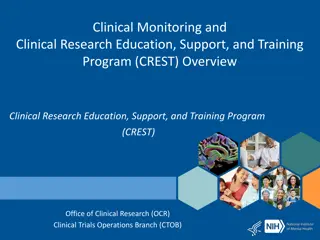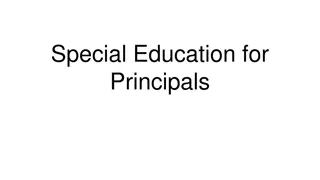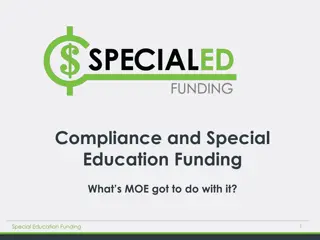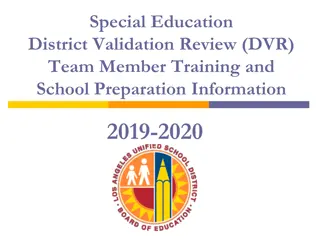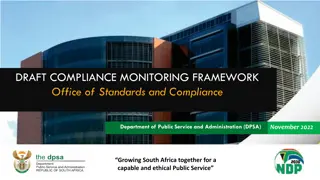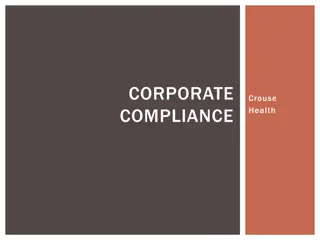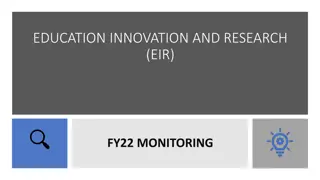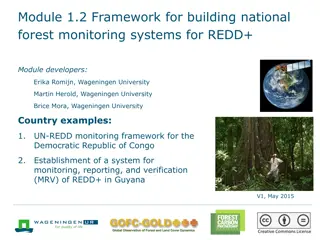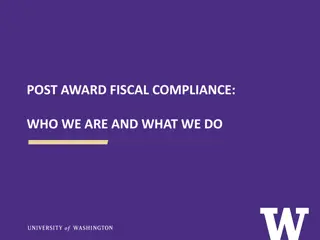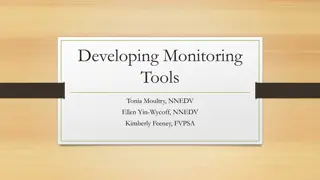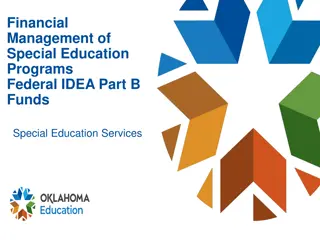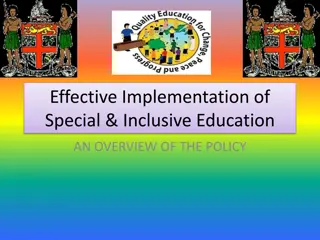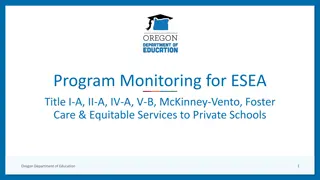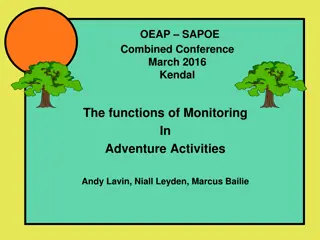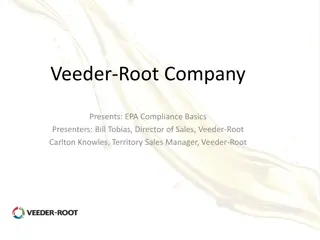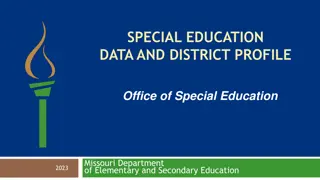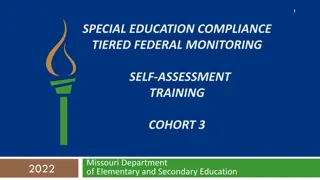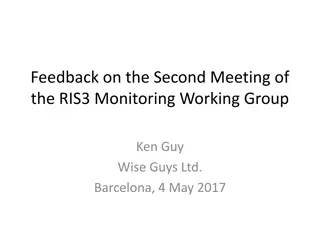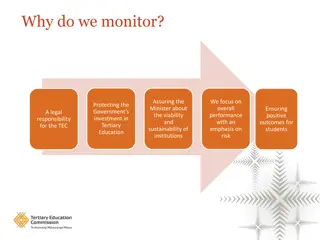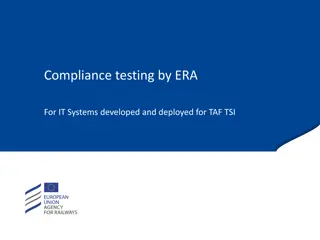Special Education Compliance Monitoring Process
Steps in the special education monitoring process for local agency self-assessment, including required activities, due dates, and available resources for assistance. Dive into Missouri's cyclical monitoring process and Cohort 1's self-assessment year. Discover the five components of the self-assessment, file review guidelines, and student file selection criteria. Prepare for training sessions, conducting self-assessments, and submission deadlines as part of the program monitoring of districts."
Download Presentation

Please find below an Image/Link to download the presentation.
The content on the website is provided AS IS for your information and personal use only. It may not be sold, licensed, or shared on other websites without obtaining consent from the author.If you encounter any issues during the download, it is possible that the publisher has removed the file from their server.
You are allowed to download the files provided on this website for personal or commercial use, subject to the condition that they are used lawfully. All files are the property of their respective owners.
The content on the website is provided AS IS for your information and personal use only. It may not be sold, licensed, or shared on other websites without obtaining consent from the author.
E N D
Presentation Transcript
1 SPECIAL EDUCATION COMPLIANCE TIERED FEDERAL MONITORING SELF-ASSESSMENT TRAINING COHORT 1 Missouri Department of Elementary and Secondary Education 2023
Learning Objectives 2 Participants will learn 1. the steps in the special education monitoring process for local agency self-assessment, 2. the required activities for the self-assessment and their due dates, and 3. how to find resources for assistance with questions.
Program Monitoring of Districts 3 Missouri utilized a 3-year cyclical monitoring process. Cohort 1 is beginning their self-assessment year. The cyclical monitoring process includes: Self-Assessment (Year 1) Corrective Action (Year 2) Maintain & Retrain (Year 3)
Self-Assessment Year 1 5 Training for Self-Assessment - October 2023 Conduct Self-Assessment - November 2023 - January 2024 Submit Self-Assessment in IMACS 2.0 - February 1, 2024 Submit Verification Documentation for the Desk Review - April 1, 2024 Submit Timelines (Initial/C to B) - May 15, 2024
Five Components of the Self-Assessment 6 1. File Review 2. Initial Evaluation Timelines 3. C to B Transition Timelines 4. Upload requested documents in IMACS 2.0 5. Parent Surveys
File Review: Number of Student Files Included 7 Based on the December 1, 2022 child count for the agency, the following number of files should be used as a guideline for determining the total number of files included in file review:
File Review: Selecting Student Files 8 Student files selected by the district for self-assessment should represent: A cross section of ages, grade levels, and buildings within the district, including ECSE students and students with postsecondary transition plans, that have had an initial evaluation, a reevaluation, or have post-secondary transition IEP completed since January 2023 Provide a variety of disabilities and placements. Select districts will be asked for specific conditional areas such as: Intellectual Disabilities (ID), Other Health Impaired (OHI), and Specific Learning Disability (SLD) Students from your districts who are enrolled in an Approved Private Agency or virtual learning. (See next slide for more information.) Select files for students who were evaluated or reevaluated in the current (23/24) and prior school year (22/23). DO NOT submit files that used triennial waivers. Avoid using transfer student s files, if possible.
Students Attending Approved Private Agencies or Enrolled in Virtual Learning 9 Districts who have full-time students placed in a DESE Approved Private Agency (APA) must include one or more of those students in their self-assessment file review. Resident districts who have full time students enrolled in virtual learning through an Memorandum of Understand (MOU) or enrolled with a non-hosted MOCAP provider must include one or more of those students in their self-assessment file review. Host districts who have full time students enrolled with their hosted MOCAP provider must include one or more of those students in their self-assessment file review.
Students Attending Approved Private Agencies or Enrolled in Virtual Learning 10 Number of students placed in an APA, enrolled in virtual learning through their resident district, or enrolled in virtual learning with a host district Number of files to include in their self-assessment selection Up to 5 students 1 or 2 student files 6 to 10 students 3 or 4 student files 11 to 19 students 5 or 6 student files 20 or more students 7 student files APA or virtual learning files selected must be an initial evaluation, a reevaluation, or have post-secondary transition IEP completed since January 2023 as described in the selection criteria on slide 8.
Required/Conditional Indicators 11 Required Indicators Conditional Indicators Referral (initial only) MAP-A Evaluation Eligibility (SLD, OHI, ID) Reevaluation Long Term Suspensions IEP Present Level of Academic and Functional Performance Annual Goals and Goal Progress Reports Postsecondary Transition
File Review: Selecting a Variety of Files 12 Initial Evaluations When conditional indicators are triggered, include students eligible using criteria for SLD, ID and/or OHI. Conditional indicators need initial evaluation for review. Reevaluations (with and without assessment) NO triennial waivers, these are NOT reevaluations IEPs A variety of grade levels and placements including one or two ECSE students as well as students enrolled in APAs and virtual learning A minimum of five IEPs with postsecondary transition plans IEPs for students enrolled in MAP-A when conditional indicators are included
Enter Student Demographic Data In IMACS 2.0 13 There are now two ways to add data: Type individual student demographic data in IMACS 2.0. Upload bulk student demographic data to IMACS 2.0 via a CSV file.
File Review: Assemble Documents 14 Initial Evaluations Referral, review of existing data, evaluation report, and IEP Prior Written Notices and Meeting Notifications IEP Goal Progress Reports (copies of what was sent to the parent) Meeting Notes or Contact Logs, if applicable Discipline documentation (if discipline is a conditional indicator) Documents with a Parent Signature (when required)
File Review: Conducting Self-Assessment 15 Read the entire indicator. Refer often to the Special Education Compliance Program Standards and Indicators manual for guidance and clarification. Do not rely only on the IMACS 2.0 checklist language. Determinations are Yes = documentation is present/correct No = documentation does not meet compliance N/A = indicator doesn t apply
Documentation for the Desk Review Verification 16 Upon request by the DESE compliance supervisor, upload documentation from the files of specific students chosen for the desk review. Upload to IMACS 2.0 no later than April 1, 2024. DESE supervisors will review and verify each district s self-assessment in IMACS 2.0 during desk monitoring conducted from April through August 2024. Provide your supervisor with summer contact info (cell phone #, email address) in case they have questions or need additional documentation to complete the verification. Keep an electronic copy of the documents, including those that have signatures, in an easy-to-access, central location.
Timelines: Submission 17 Timeline submission due May 15, 2024. Initial Evaluations Include all students with initial evaluations (ineligible and eligible). Include initial evaluations that began after July 1, 2023 and are finished before April 30, 2024 Part C to Part B Transition Include children who were referred from First Steps between July 1, 2023 and April 30, 2024 and whose third birthday occurs before April 30, 2024.
Parent Surveys 19 Purpose is to increase parent engagement and provide data for State Performance Plan (SPP) Indicator 8 which states: Percent of parents with a child receiving special education services, who report school facilitated parent involvement as a means of improving services and results for children with disabilities. All parents of students with disabilities served by the LEA should participate in the Parent Survey. During first semester of the 2023-24 school year, University of Missouri Institute of Public Policy (IPP) will send out the survey, LEAs provide parent with the survey or a survey link, and parents complete the survey and mail it back to the IPP or submit it electronically. LEA will receive results of surveys to use in planning for increasing parent involvement.
Resources for Tiered Monitoring and IMACS 20 DESE s Self-Assessment (Year 1) Guidance and Resources Copies of both PowerPoints presented today List of Things to Remember for Self-Assessment Self-Assessment Procedures for Monitoring LEA Special Education Compliance Monitoring Checklist Tiered Monitoring Flowchart
Compliance Consultants Region Compliance Consultant Phone Number Email 1. Southeast Tiffiney Smith 573-651-2621 tdsmith@semo.edu 2. Heart of Missouri Lynn Lynch 573-424-7847 lynchly@missouri.edu 3. Kansas City Bailey Tennesen 816-235-5957 tennesenb@umkc.edu 4. Northeast Dawn Lichtenberg 660-785-6080 dlichtenberg@truman.edu 5. Northwest Julia Schmitz julia@nwmissouri.edu 660-562-1995 Leasa Day ldnd3@mst.edu 6. South Central 573-341-6821 7. Southwest Amy Phipps 417-836-4082 amyphipps@missouristate.edu 8. St. Louis Jeanne Rothermel 314-724-6736 jrothermel@edplus.org 9. Central Julie Harris 660-232-0387 jlharris@ucmo.edu
Questions? Please contact: 22 Office of Special Education Special Education Compliance (Part B) P.O. Box 480, Jefferson City, MO 65102-0480 Phone: 573-751-0699 Email: secompliance@dese.mo.gov
23 The Department of Elementary and Secondary Education does not discriminate on the basis of race, color, religion, gender, national origin, age, or disability in its programs and activities. Inquiries related to Department programs and to the location of services, activities, and facilities that are accessible by persons with disabilities may be directed to the Jefferson State Office Building, Office of the General Counsel, Coordinator Civil Rights Compliance (Title VI/Title IX/504/ADA/Age Act), 6th Floor, 205 Jefferson Street, P.O. Box 480, Jefferson City, MO 65102-0480; telephone number 573-526-4757 or TTY 800-735-2966; fax number 573-522-4883; email civilrights@dese.mo.gov

 undefined
undefined









